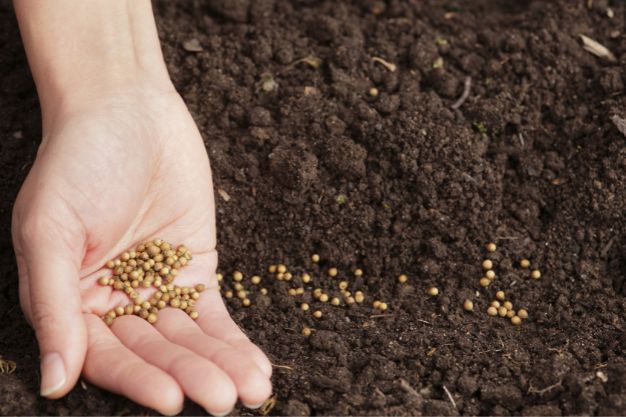
It’s a grave mistake to leave cilantro microgreens out of your indoor garden in New York. These microgreens are the new superfoods getting praise from chefs and dieticians alike, and for good reasons.
The little plants are not so little when it comes to their nutritional value. They are rich in Vitamins A, C, and K, calcium, and potassium and are a nutritious addition to your meals without a hefty price tag. Furthermore, they have an irresistible flavor and are easy to grow indoors.
Do cilantro microgreens taste better than cilantro? How long do they take to grow? We answer these questions and give a step-by-step guide on how to grow cilantro microgreens in your New York Garden.
Is Cilantro a Microgreen or a Sprout?
The difference between cilantro and cilantro microgreens is the harvest time. So, what do cilantro microgreens look like?
When they first sprout, they have two grass-like cotyledon leaves, which taste just as good as cilantro. Immediately after the first true leaves appear, the microgreens have a full cilantro flavor.
Growing microgreen cilantro is faster, and the plant is way more nutritious than full-grown cilantro since you harvest when they are newly sprouted and are still getting nutrients from the endosperm.
In the case of cilantro, as the plant matures, it relies on the soil nutrients, which may be variable depending on soil quality.
Growing Cilantro Microgreens Step by Step
Now, let’s get into the fun part and learn how to turn cilantro seeds into delicious microgreens.
As an Amazon Associate we earn from qualifying purchases. Some links on this site may direct you to Amazon where we earn a small commission from each sale at no extra cost to you.
Here is the step-by-step guide on how to grow cilantro microgreens.
1. Assemble the materials
You first assemble the materials like planting trays and cilantro seeds. The tray should have drainage holes to make watering easy. You will also need a spray water bottle and kitchen scissors later for harvesting.
When growing cilantro microgreens, you’ll harvest them before they become fully grown, so shallow planting trays will work.
You won’t need fertilizer since microgreens get nutrients from the seed. What you need is a soil mix that is fine and has enough moisture to enrich the plants.
2. Soaking
You don’t have to soak cilantro seeds. Although soaking may speed up germination, it doesn’t necessarily make the plant grow faster.
If you choose to soak, place the seeds in a bowl of clean water for 12-24 hours maximum, then plant them right after.
An alternative to soaking is to crush the seeds with a rolling pin to have a similar effect to soaking. Crushing splits the seeds into halves. The seed has two halves, each with an embryo that will germinate and grow into an individual plant.
But you can skip this step as it’s not necessary. The seeds will still germinate even if you don’t crush or soak them.
3. Planting
Fill the growing tray with damp soil and spread evenly. Then, spread the seeds evenly on the surface. Cilantro microgreens need more space because they grow longer, so avoid overlapping. You don’t have to cover the seeds with soil.

Use the water spray bottle and moisten the seeds and soil. Then, cover the tray to block out light to allow the seeds to germinate. Cilantro seeds need about 70 degrees Fahrenheit at a cooler temperature to germinate.
The seeds take about 2 -6 days to germinate. Check on them every other day and water them as if the soil looks dry.
4. Sprouting
Once the seeds germinate and sprout, remove the cover, expose them to sunlight, or use the grow light. They may be white because of a lack of light but will soon turn green once they get enough light.
Keep the microgreens in a location with consistent light. Keep the tray under sunlight, or use the grow light for 12 hours to ensure it covers all the plants.

Also, start watering from the bottom through the drainage holes in the tray to keep out mold. Fill another tray or dish with water and place it under the tray with cilantro microgreens. The soil will draw water from below and keep the sprouts dry.
The microgreens require water to grow. Check every other day to ensure they are getting enough water.
5. Harvesting
Keep monitoring the plants until they form their true leaves and are ready to harvest. They should be about an inch or taller. The process takes about 10 to 20 days for the cilantro microgreens to be ready for harvest. This is the peak time for the flavor and nutrition.
Don’t water the cilantro microgreens 12 hours before you harvest them to keep away excess moisture and make the greens easy to last in storage.

Use your kitchen scissors to snip the stems just above the soil level. The cilantro microgreens have a flexible harvesting window, so you can harvest just what you need and don’t have to harvest all at once.
The microgreens taste great when fresh. Wash them in cold water and add them to your salads, soups, stews, smoothies, or eggs.
If you need to harvest more but won’t use all of it at once, don’t wash them. Keep them as dry as possible. To store, press them between two paper towels and seal them in an airtight container to last 5 to 10 days in the refrigerator.
Wrapping Up How to Grow Cilantro Microgreens
Here is a recap of the whole process of growing cilantro microgreens. First, plant the seeds in a tray with moist soil and keep them in a warm place. Cover, and in about 5-6 days, the seeds will germinate. Then, after 14 days, the true leaves will form, and the microgreens will be ready for harvest. This process yields delicious and nutritious cilantro microgreens in a few weeks, and you’ll be ready to enjoy them.
If you want to add more flavor and nutrition to your diet, consider growing cilantro microgreens in your indoor garden, whether you’re a professional or just doing it for fun. Happy farming!
FAQs
- How long does cilantro microgreens take to grow?
It takes about 21 to 25 days from the day of planting for cilantro microgreens to be ready for harvest.
- Do you soak cilantro microgreens seeds before planting?
Soaking cilantro seeds makes them germinate faster within a short time than non-soaked seeds. However, it doesn’t make much difference in the overall growth rate.
- What is the difference between cilantro and microgreen cilantro?
The difference between growing cilantro microgreens and cilantro is the harvesting time. You harvest the microgreens as soon as the true leaves form to retain the flavor.
- Does cilantro regrow after cutting?
Cilantro microgreens don’t regrow because you snip all the growth nodules while harvesting. However, full-grown cilantro can regrow after harvesting and be used longer.






Comments (5)
Eggplant Growing Stages: How to Grow Eggplant Step by Step - City Green Thumbsays:
October 23, 2023 at 12:03 pm[…] How to Grow Cilantro Microgreens […]
How to Grow Micro Broccoli Indoors Fast and Easy - City Green Thumbsays:
November 2, 2023 at 4:27 pm[…] have explored how to grow microgreens from plants such as cilantro, radish, leeks, and cauliflower. So why not micro […]
How to Grow Leek Microgreens Fast and Easy at Home - City Green Thumbsays:
November 11, 2023 at 1:04 pm[…] How to Grow Cilantro Microgreens […]
How to Grow Kale Microgreens Indoors Fast and Easy - City Green Thumbsays:
March 20, 2024 at 11:15 am[…] How to Grow Cilantro Microgreens […]
What are the Best Microgreens to Grow for Profit? - City Green Thumbsays:
June 7, 2024 at 10:50 am[…] See more: How to Grow Cilantro Microgreens […]